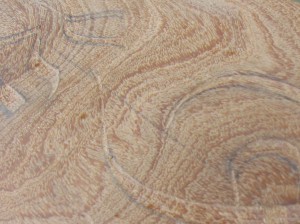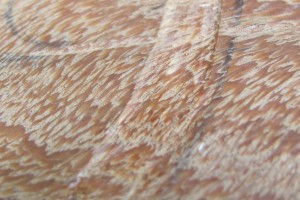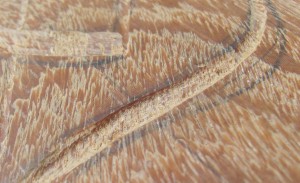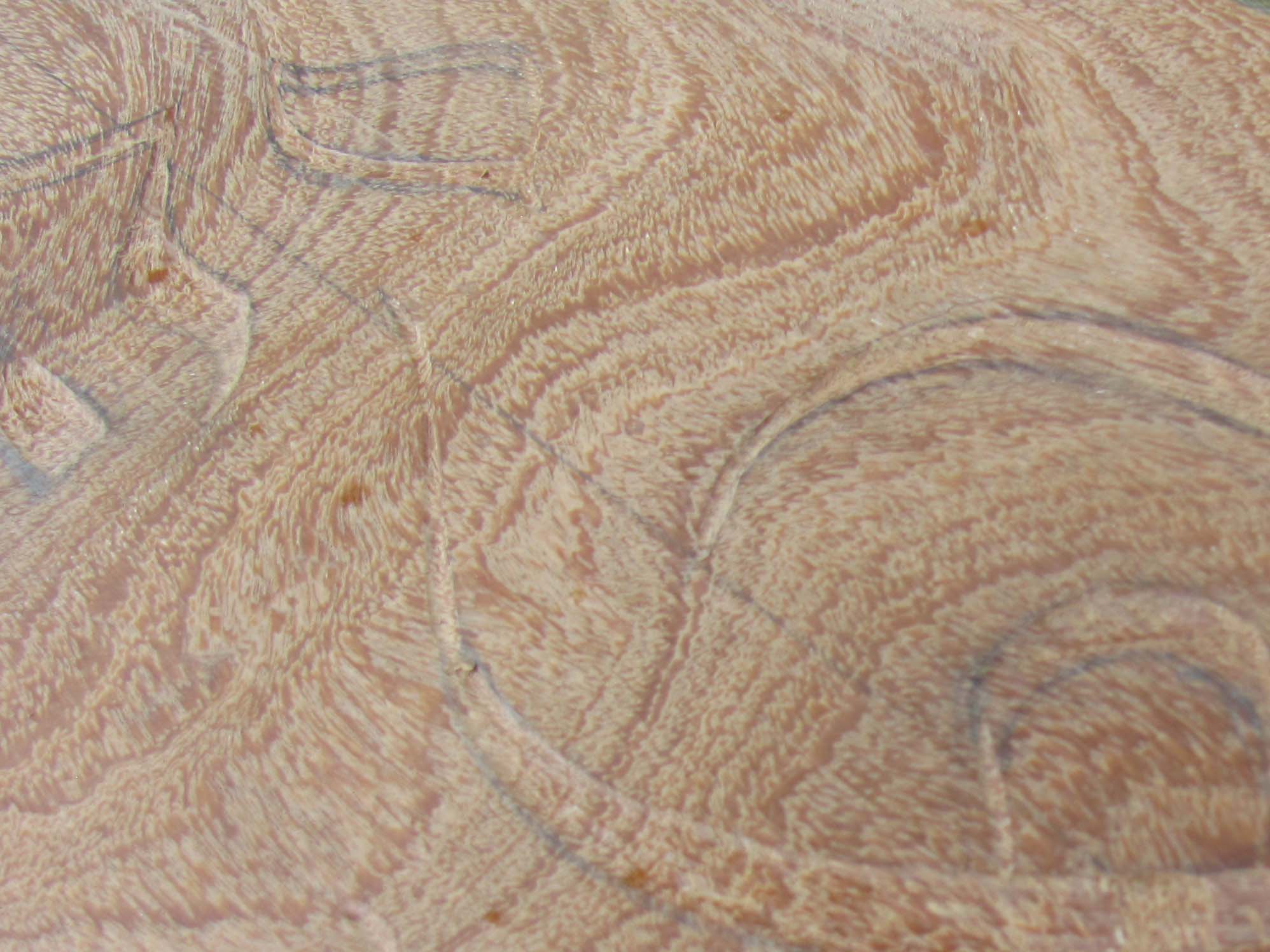Struggling with Cumaru

I learn all kinds of things by carving the Alphabets—about various cultures, about writing itself, about spirituality, about physics, about the history of technology. Nothing prepared me, though, for cumaru.
A couple of weeks ago I got a commission to carve the chant “Om Mani Padme Hum” in Tibetan, as articulated by the calligrapher Tashi Mannox. My client originally chose maple as the wood, but his eye fell on a piece of cumaru I had recently ordered through that well-known exotic lumber source, eBay.
All I knew about cumaru was that it was a tropical hardwood from Central America or northern South America, and that the photo of eBay made it look really wild. When it arrived, though, the surprises took over.
First impression: it’s incredibly dense. I went to pick up the package standing outside my door and almost dropped it. Heavy as hell. But dense woods are, by and large, good for the Alphabets, as they offer a strong, crisp edge when carved. I’d just finished a carving of the maxim “Everything happens for a reason” (another Tashi Mannox creation) in yellowheart, and it came out beautifully. And yellowheart, or pau amarillo, is from the same part of the world. So I drew the characters on the wood, got out my gouges and addressed the cumaru.
My first impression was that it was like carving solid Teflon. The gouge just bounced right off the surface. Maybe I was accidentally using an old set of tools that had long gone blunt? No—this was my new set, just arrived from Warren Cutlery in New York State.
I looked harder at the cumaru. In places it has the consistency of wax that has been chilled down to a temperature of one degree above absolute zero. The color, though, suggests raw beef marbled with fat, though again its consistency suggests that the beef was shipped in a freezer car that was misrouted through, say, Fairbanks and Murmansk and arrived two years behind delivery date.
As it happened, Marc at Sterling Hardwoods had just given me a small piece of ironwood or hop hornbeam to see if I could carve it—not exactly as a challenge, but certainly with a sense that it would be hard work. I looked up cumaru on the Janka Hardness scale and found it is more than twice as hard as ironwood. It’s right up there above ebony, which is like carving coal, but in its way much more difficult to work because of the grain.

It has what I can only describe as a paisley surf grain, swirling and breaking everywhere. That was one of the qualities that attracted me to buy the wood, but now it’s a challenge: a single stroke of the gouge may go upgrain, cross-grain and downgrain.
Over the next two days I made slow but determined inroads, always mindful of the fact that I’d recently had to suspend carving for six weeks because of a muscle tear below my shoulder.
It was a cool morning, but even so I worked up such a sweat I turned on the overhead fan, then ended up working shirtless.
I rationed myself to bursts of five minutes or less. Last night, after I finished I iced my shoulder. But that in itself has taught me a lesson: carve with your elbow resting on the table. That trick alone takes a good 30% of the effort away, I think.
The cumaru tree itself turns out to have some fascinating, not to say frightening qualities. First of all—no surprise here—it’s so tough it can live for over a thousand years. It’s a member of the pea family, of all things, and its podded seeds have a strong fragrance that gives the plant its Latin name, Dipteryx odorata. They have been used to add scent to tobacco and perfumes. Its active ingredient is coumarin, whence the plant gets its name, and that’s strong stuff: it can cause hemorrhage and liver damage and paralyze the heart. The poison warfarin is derived from coumarin. The French, of course, use the cumaru beans as a vanilla substitute in desserts and stews.
By now I guess I have at least six hours of work in this piece, which essentially consists of only three characters, and the toughest carving is nearly done.

It seems weirdly ironic, or just plain wrong, to struggle with such force to carve a mantra for calm and inner peace. Eventually I come to see the wood as exercising a kind of Gandhian passive resistance, exercising the strength one can summon simply by being.
I’m writing this, of course, to enforce a break in my carving, for my health’s sake. But even so, a twinge in my shoulder teaches me something: rest your elbow on the table, even when you type.


August 22, 2014 @ 3:25 pm
it’s just great to read your ‘break’ story, (sorry, my english isn’t as good as it should be, the piece of wood under your hands teaches you the peace and way of working and carving it, enjoy it with all your craftmanship and heart.
August 22, 2014 @ 4:10 pm
Your English is good enough to make a great point: yes, the wood teaches the carver.